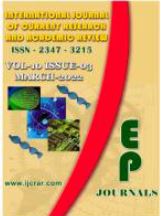Abstract Volume:10 Issue-3 Year-2022 Original Research Articles
 |
Online ISSN : 2347 - 3215 Issues : 12 per year Publisher : Excellent Publishers Email : editorijcret@gmail.com |
Apiculture is the art of rearing honey bees in artificial hives and collecting various bee products especially honey, bee bread, bee venom, bee pollen, propolis and royal jelly. Honey is a very sweet, viscous syrup produced by the honey bees as well as stingless bees which is probably the first natural sweetener ever discovered, widely used as a nutritious food supplement and medicinal agent. The physical, chemical and nutritive properties of honey fluctuate based on the floral preferences, floral sources, climatic conditions and geographic features. Honey exhibits antimicrobial, antioxidant, anti-inflammatory, anticancer, antihyperlipidemic, and cardioprotective properties. Due to these properties, it is used in the treatment of eye disorders, gastrointestinal tract diseases, neurological disorders, fertility disorders and wound healing activity. This review paper mainly focus on the biological and therapeutic effects of bee products and major contaminants in them. Bee products can be easily contaminated from different sources. The contamination can arise from beekeeping practices as well as from the environment. Environmental contaminants includes the heavy metals lead, cadmium and mercury, radioactive isotopes, organic pollutants, pesticides (insecticides, fungicides, herbicides and bactericides), pathogenic bacteria and genetically modified organisms. The contaminants from beekeeping includes acaricides: lipophylic synthetic compounds and non-toxic substances such as organic acids and components of essential oils; and antibiotics used for the control of bee brood diseases. Other substances used in beekeeping play a minor role: para-dichlorobenzene, used for the control of wax moth and chemical repellents. The degree of contamination of honey, pollen, beeswax, propolis and royal jelly by the different contaminants is reviewed.
How to cite this article:
Prem Jose Vazhacharickal. 2022. Honey Bee Products and their Contaminants: An Overview.Int.J.Curr.Res.Aca.Rev. 10(3): 27-48doi: https://doi.org/10.20546/ijcrar.2022.1003.004



Quick Navigation
- Print Article
- Full Text PDF
- How to Cite this Article
- on Google
- on Google Scholor
- Citation Alert By Google Scholar
